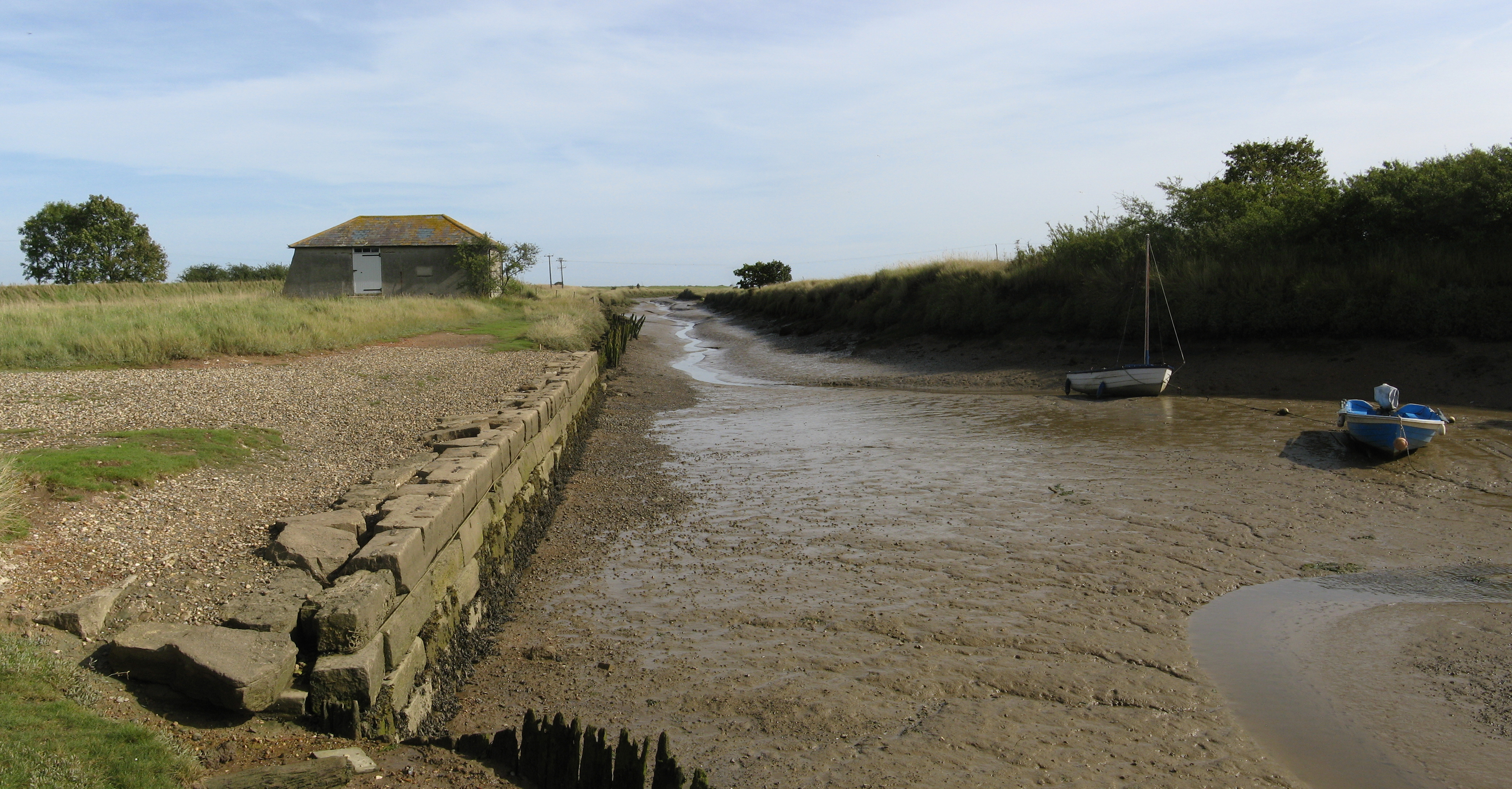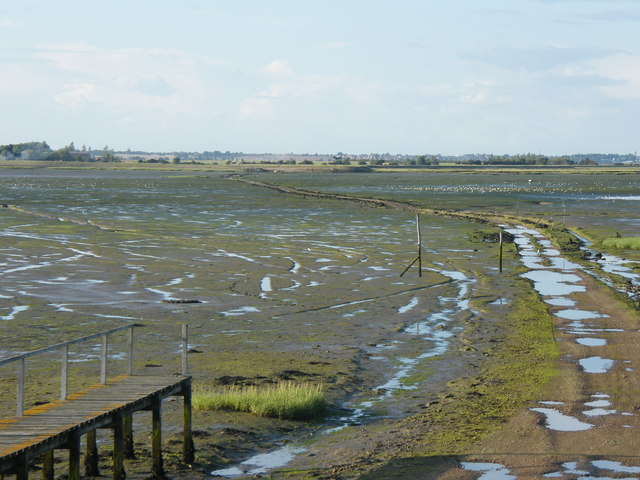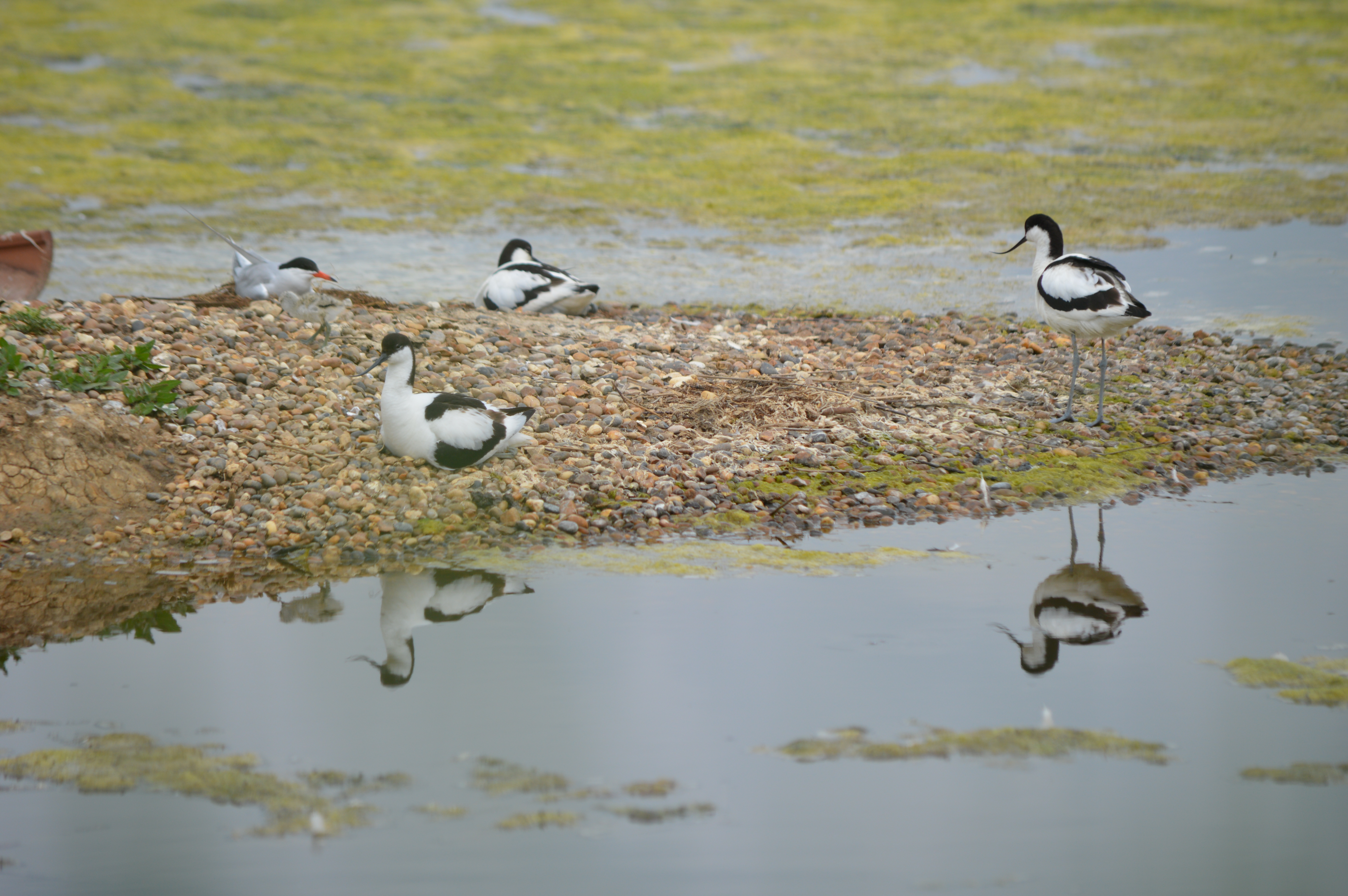|
Hamford Water
Hamford Water is a biological Site of Special Scientific Interest between Walton-on-the-Naze and Harwich in Essex. The site is a tidal inlet which has marsh grasslands, creeks, mud and sand flats, salt marshes, islands and beaches. It is described by Natural England as "of international importance for breeding little terns and wintering dark-bellied brent geese, wildfowl and waders, and of national importance for many other bird species." Rare plants include hog's fennel and slender hare's-ear. The main invertebrates are worms and thin-shelled molluscs. The largest island, Horsey Island, can be reached on foot at low tide across The Wade from Kirby-le-Soken. It is also a Ramsar site, a Special Protection Area, a Nature Conservation Review site, and most of it is a National Nature Reserve. Two small areas, Skippers Island and John Weston Nature Reserve, are managed by the Essex Wildlife Trust. Most of Bramble Island (now part of the mainland) is used by Exchem for explosive ... [...More Info...] [...Related Items...] OR: [Wikipedia] [Google] [Baidu] |
Hamford Water
Hamford Water is a biological Site of Special Scientific Interest between Walton-on-the-Naze and Harwich in Essex. The site is a tidal inlet which has marsh grasslands, creeks, mud and sand flats, salt marshes, islands and beaches. It is described by Natural England as "of international importance for breeding little terns and wintering dark-bellied brent geese, wildfowl and waders, and of national importance for many other bird species." Rare plants include hog's fennel and slender hare's-ear. The main invertebrates are worms and thin-shelled molluscs. The largest island, Horsey Island, can be reached on foot at low tide across The Wade from Kirby-le-Soken. It is also a Ramsar site, a Special Protection Area, a Nature Conservation Review site, and most of it is a National Nature Reserve. Two small areas, Skippers Island and John Weston Nature Reserve, are managed by the Essex Wildlife Trust. Most of Bramble Island (now part of the mainland) is used by Exchem for explosive ... [...More Info...] [...Related Items...] OR: [Wikipedia] [Google] [Baidu] |
Coastal Environment Of Essex
The coast, also known as the coastline or seashore, is defined as the area where land meets the ocean, or as a line that forms the boundary between the land and the coastline. The Earth has around of coastline. Coasts are important zones in natural ecosystems, often home to a wide range of biodiversity. On land, they harbor important ecosystems such as freshwater or estuarine wetlands, which are important for bird populations and other terrestrial animals. In wave-protected areas they harbor saltmarshes, mangroves or seagrasses, all of which can provide nursery habitat for finfish, shellfish, and other aquatic species. Rocky shores are usually found along exposed coasts and provide habitat for a wide range of sessile animals (e.g. mussels, starfish, barnacles) and various kinds of seaweeds. Along tropical coasts with clear, nutrient-poor water, coral reefs can often be found between depths of . According to a United Nations atlas, 44% of all people live within 5 km (3.3mi) ... [...More Info...] [...Related Items...] OR: [Wikipedia] [Google] [Baidu] |
Nature Conservation Review Sites
Nature, in the broadest sense, is the physical world or universe. "Nature" can refer to the phenomena of the physical world, and also to life in general. The study of nature is a large, if not the only, part of science. Although humans are part of nature, human activity is often understood as a separate category from other natural phenomena. The word ''nature'' is borrowed from the Old French ''nature'' and is derived from the Latin word ''natura'', or "essential qualities, innate disposition", and in ancient times, literally meant "birth". In ancient philosophy, ''natura'' is mostly used as the Latin translation of the Greek word ''physis'' (φύσις), which originally related to the intrinsic characteristics of plants, animals, and other features of the world to develop of their own accord. The concept of nature as a whole, the physical universe, is one of several expansions of the original notion; it began with certain core applications of the word φύσις by pre-Socr ... [...More Info...] [...Related Items...] OR: [Wikipedia] [Google] [Baidu] |
Sites Of Special Scientific Interest In Essex
Site most often refers to: * Archaeological site * Campsite, a place used for overnight stay in an outdoor area * Construction site * Location, a point or an area on the Earth's surface or elsewhere * Website, a set of related web pages, typically with a common domain name It may also refer to: * Site, a National Register of Historic Places property type * SITE (originally known as ''Sculpture in the Environment''), an American architecture and design firm * Site (mathematics), a category C together with a Grothendieck topology on C * ''The Site'', a 1990s TV series that aired on MSNBC * SITE Intelligence Group, a for-profit organization tracking jihadist and white supremacist organizations * SITE Institute, a terrorism-tracking organization, precursor to the SITE Intelligence Group * Sindh Industrial and Trading Estate, a company in Sindh, Pakistan * SITE Centers, American commercial real estate company * SITE Town, a densely populated town in Karachi, Pakistan * S.I.T.E Indust ... [...More Info...] [...Related Items...] OR: [Wikipedia] [Google] [Baidu] |
Special Protection Areas In England
Special or specials may refer to: Policing * Specials, Ulster Special Constabulary, the Northern Ireland police force * Specials, Special Constable, an auxiliary, volunteer, or temporary; police worker or police officer Literature * ''Specials'' (novel), a novel by Scott Westerfeld * ''Specials'', the comic book heroes, see ''Rising Stars'' (comic) Film and television * Special (lighting), a stage light that is used for a single, specific purpose * ''Special'' (film), a 2006 scifi dramedy * ''The Specials'' (2000 film), a comedy film about a group of superheroes * ''The Specials'' (2019 film), a film by Olivier Nakache and Éric Toledano * Television special, television programming that temporarily replaces scheduled programming * ''Special'' (TV series), a 2019 Netflix Original TV series * ''Specials'' (TV series), a 1991 TV series about British Special Constables * ''The Specials'' (TV series), an internet documentary series about 5 friends with learning disabiliti ... [...More Info...] [...Related Items...] OR: [Wikipedia] [Google] [Baidu] |
Beaumont Cut
Beaumont Cut was a canal linking Beaumont Quay, in the parish of Beaumont-cum-Moze, Tendring, Essex, England, with Hamford Water and the North Sea. It was opened in 1832 but fell into disuse and was closed at some time in the 1930s. History Archaeological studies suggest that the first canal on the site was built by the Romans, possibly in connection with salt extraction in the area; Roman-era pottery sherds have been found and sites of salterns identified. The nineteenth-century canal was constructed to serve the extensive coastal traffic between the agricultural hinterland of Essex and London, with produce and animal fodder being carried into the capital and manure for the fields as cargo for the return trip. The proprietors of the venture were the governors of Guy’s Hospital, who owned agricultural estates in the area. They were granted supplies of stone from Old London Bridge (demolished in 1831) for the purpose. Two vessels, the Thames barges ''Beaumont Belle'' and ''T ... [...More Info...] [...Related Items...] OR: [Wikipedia] [Google] [Baidu] |
Secret Water
''Secret Water'' is the eighth book in Arthur Ransome's ''Swallows and Amazons'' series of children's books. It was published on 28 November 1939. This book is set in and around Hamford Water in Essex, close to the resort town of Walton-on-the-Naze. It starts only a few days after ''We Didn't Mean to Go to Sea'' ends. It brings the Swallows and the Amazons together and introduces a new group of characters, the Eels and the Mastodon. Ransome used to sail to Hamford Water, an area of tidal salt marshes and low-lying islands, in his yacht ''Nancy Blackett''. He set the book here to offer his characters new opportunities to explore and make maps in a different landscape. Plot summary The Swallows intend to sail in the ''Goblin'' (as featured in ''We Didn't Mean to Go to Sea'') to Hamford Water and camp with their father, but he is called away on naval business. To compensate, he maroons them with a small dinghy on an island. Before he leaves, Father gives them an outline map ... [...More Info...] [...Related Items...] OR: [Wikipedia] [Google] [Baidu] |
Arthur Ransome
Arthur Michell Ransome (18 January 1884 – 3 June 1967) was an English author and journalist. He is best known for writing and illustrating the ''Swallows and Amazons'' series of children's books about the school-holiday adventures of children, mostly in the Lake District and the Norfolk Broads. The entire series remains in print, and ''Swallows and Amazons'' is the basis for a tourist industry around Windermere and Coniston Water, the two lakes Ransome adapted as his fictional North Country lake. He also wrote about the literary life of London, and about Russia before, during, and after the revolutions of 1917. His connection with the leaders of the Revolution led to him providing information to the Secret Intelligence Service, while he was also suspected by MI5 of being a Soviet spy. Early life Ransome was the son of Cyril Ransome (1851–1897) and his wife Edith Ransome (née Baker Boulton) (1862–1944). Arthur was the eldest of four children: he had two sisters Cecily ... [...More Info...] [...Related Items...] OR: [Wikipedia] [Google] [Baidu] |
EPC Groupe
EPC Groupe (Explosifs Produits Chimiques S.A.) is a French multinational company that trades in explosives and drilling; It is one of the world’s leaders in explosives manufacture, storage and distribution and in particular drilling and blasting. History It was founded in 1893 bEugène-Jean Barbierand its first implantation was in Saint-Martin-de-Crau (France). Structure It is headquartered in La Défense (France). It has ovefifty subsidiarycompanies around the world. United Kingdom In the UK it has two sites, in Somercotes, Derbyshire and Great Oakley, Essex, known as EPC-UK. It began in the UK in 1905. The UK head office is south of the A38, at the B600 junction. It started in the UK as Explosives and Chemical Products (ECP), later part of Exchem. It has a 12,000 acre test site on the Essex coast at Hamford Water in Tendring Tendring is a village and civil parish in Essex. It gives its name to the Tendring District and before that the Tendring Hundred. Its name w ... [...More Info...] [...Related Items...] OR: [Wikipedia] [Google] [Baidu] |
Essex Wildlife Trust
The Essex Wildlife Trust (EWT) is one of 46 wildlife trusts which cover the United Kingdom. The EWT was founded in 1959, and it describes itself as Essex's leading conservation charity, which aims to protect wildlife for the future and the people of the county. As of January 2017, it has over 34,000 members and runs 87 nature reserves, 2 nature parks and 11 visitor centres. Essex has one of the longest coastlines of any English county, with saltmarshes, lagoons, mudflats, grazing marshes, reedbeds and shingle. Its ancient forests were formerly important to the local economy, with wood being used for fuel, construction and bark in the tanning industry. Coppicing is being re-introduced by the EWT to encourage woodland grasses, flowers, invertebrates and birds. A few grasslands on the heavy clays of south- and mid-Essex are still grazed according to traditional methods, supporting a mixture of pasture and fen. Some brownfield sites, often on contaminated soil, have populations of na ... [...More Info...] [...Related Items...] OR: [Wikipedia] [Google] [Baidu] |
John Weston Nature Reserve
John Weston Nature Reserve is a nature reserve north of Walton-on-the-Naze in Essex. It is managed by the Essex Wildlife Trust. This site is named after its former warden, who died in 1984. It has rough grassland, blackthorn and bramble scrub and four ponds. Nesting birds include the lesser and common whitethroat, and there are flora such as slender thistle, pepper saxifrage and fenugreek Fenugreek (; ''Trigonella foenum-graecum'') is an annual plant in the family Fabaceae, with leaves consisting of three small obovate to oblong leaflets. It is cultivated worldwide as a semiarid crop. Its seeds and leaves are common ingredients .... There is access from Naze Park Road. References {{coord, 51.873, 1.290 , type:landmark_region:GB-BNE, display=title Essex Wildlife Trust ... [...More Info...] [...Related Items...] OR: [Wikipedia] [Google] [Baidu] |


.jpg)


